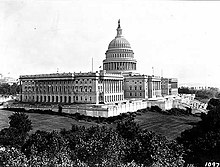50th United States Congress
| 50th United States Congress | |
|---|---|
49th ← → 51st | |
 United States Capitol (1906) | |
March 4, 1887 – March 4, 1889 | |
| Members | 76 senators 325 representatives 8 non-voting delegates |
| Senate majority | Republican |
| Senate President | Vacant |
| House majority | Democratic |
| House Speaker | John G. Carlisle |
| Sessions | |
| 1st: December 7, 1887 – October 20, 1888 2nd: December 3, 1888 – March 3, 1889 | |
The Fiftieth United States Congress was a meeting of the legislative branch of the United States federal government, consisting of the United States Senate and the United States House of Representatives. It met in Washington, D.C. from March 4, 1887 to March 4, 1889, during the third and fourth years of Grover Cleveland's first presidency. The apportionment of seats in the House of Representatives was based on the Tenth Census of the United States in 1880. The Senate had a Republican majority, and the House had a Democratic majority.
Major events
Major legislation
- October 8, 1888: Chinese Exclusion Act (Scott Act)
- January 14, 1889: Nelson Act of 1889
- February 22, 1889: Enabling Act of 1889
Party summary
The count below identifies party affiliations at the beginning of the first session of this Congress, and includes members from vacancies and newly admitted states, when they were first seated. Changes resulting from subsequent replacements are shown below in the "Changes in membership" section.
Senate
- Democratic: 37
- Republican: 39 (majority)
TOTAL members: 76
House of Representatives
- Democratic: 167 (majority)
- Republican: 152
- Independent Republican: 2
- Labor: 2
- National Greenback: 1
- Independent: 1
TOTAL members: 325
Leadership
Senate
- President: Vacant
- President pro tempore: John J. Ingalls (R)
House of Representatives
- Speaker: John G. Carlisle (D)
Members
Senate
Senators were elected by the state legislatures every two years, with one-third beginning new six-year terms with each Congress. Preceding the names in the list below are Senate class numbers, which indicate the cycle of their election. In this Congress, Class 1 meant their term began in this Congress, requiring reelection in 1892; Class 2 meant their term ended in this Congress, requiring reelection in 1888; and Class 3 meant their term began in the last Congress, requiring reelection in 1890.
House of Representatives
The names of members of the House of Representatives are preceded by their district numbers.
Changes in membership
The count below reflects changes from the beginning of this Congress.
Senate
- replacements: 1
- Democratic: no net change
- Republican: no net change
- Liberal Republican: 1 seat net loss
- deaths: 0
- resignations: 1
- interim appointments: 1
- Total seats with changes: 2
House of Representatives
- replacements: 8
- Democratic: no net change
- Republican: no net change
- deaths: 4
- resignations: 5
- contested election: 0
- Total seats with changes: 9
Administrative officers
Senate
House of Representatives
- Chaplain: William H. Milburn (Methodist)
- Clerk: John B. Clark, Jr.
- Doorkeeper: Alvin B. Hurt
- Clerk at the Speaker’s Table: Nathaniel T. Crutchfield
- Postmaster: Lycurgus Dalton
- Sergeant at Arms: John P. Leedom
References
- Martis, Kenneth C. (1989). The Historical Atlas of Political Parties in the United States Congress. New York: Macmillan Publishing Company.
{{cite book}}: Cite has empty unknown parameter:|coauthors=(help) - Martis, Kenneth C. (1982). The Historical Atlas of United States Congressional Districts. New York: Macmillan Publishing Company.
{{cite book}}: Cite has empty unknown parameter:|coauthors=(help)


